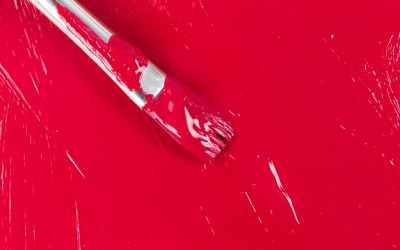Crimson is a shade of red that has been used in art and decoration for centuries. Yet, most people still confuse crimson with scarlet or oxblood.
It is a deep, vibrant red paint with purple undertones, which you can make by mixing colors from natural and synthetic materials.
You can use crimson to create dramatic effects in art, interior design, and other crafts like woodwork, pottery, and glasswork.
Crimson evokes passion, anger, or danger. A DIY crimson paint can save you money while allowing you to experiment with different shades.
Our extensively researched article will teach you how to make crimson paint in six simple steps. But first, what does the crimson color look like?
How To Make Crimson Paint
To produce a vibrant crimson color, you can combine a true red hue with a combination of white and purple paint. By carefully blending these colors in the appropriate proportions, you can achieve a stunning crimson shade suitable for various applications such as painting walls, furniture, canvas, or even as a watercolor medium.
What Color is Crimson Red?
The word “crimson” comes from the Arabic word “qirmiz,” or “red.” A glance at the color reveals a deep red color.
But an even closer look reveals a purplish undertone. It is a bold and eye-catching color that can add a touch of excitement and symbolism to any project.

What is Crimson Paint?
Crimson red paint can be a liquid or powder applied to a surface to give it a deep, vibrant red color with purple undertones.
It is made of crimson colors, binders, solvents, and additives. The paint can change a surface’s color, texture, or finish.
Remember that the paint’s durability depends on the paint type, surface, application method, and number of coats.
History of Crimson Paint
The ancient Egyptians (3100-332 BC) were the first known civilization to use different shades of crimson in religious objects and to dye fabrics.
They made the paint using various materials, including the cochineal insect, the kermes insect, and the madder plant.
The dried bodies of the female kermes and cochineal insects were crushed and used to make a red dye.
The madder plant is mainly found in Asia, Europe, and North Africa, where early civilizations used its red roots to make crimson dye.
In the Middle Ages (476–1453), crimson paint was used to paint religious icons and frescoes. It was also used to dye clothing and to create works of art.
However, crimson became popular during the Renaissance, as evidenced by portrait and landscape paintings of 1453 to 1600.
For example, Leonardo da Vinci’s Mona Lisa and Michelangelo’s Sistine Chapel ceiling used crimson paint.
But it was in the 19th century that crimson red became associated with romance.
19th-century artists like Vincent van Gogh and Claude Monet used paint to depict passion, love, and nature in paintings like Water Lilies and The Starry Night.
Synthetic crimson paint was developed in the early 20th century using chemicals like alizarin and purple dye.
These developments made crimson color less expensive and easier to make than the natural crimson from insects and plants.
What Materials and Tools Do You Need to Make Crimson Paint?
Ensure you have the following equipment and tools before you start making crimson red paint:
- Gloves: protects your hands from the paint
- Respirator: Protects your lungs from paint fumes
- Goggles: Protects your eyes from the paint
- Grinder or mortar and pestle: To grind the pigments into fine powder
- Stirring stick: For stirring the paint mixture until it is smooth
- Mixing container
- Paintbrush: For applying and testing the paint
- Alizarin crimson
- purple paint red
- Paper towel: To clean paint spills and messes
How to Make Crimson Paint in 6 Simple Steps
Now, follow the steps below.
Step 1: Put on your safety gear
Alizarin crimson and purple dye are synthetic pigments. Therefore, a lack of protective gear when mixing them can result in skin irritation, respiratory problems, and even cancer.
Therefore, the first step to making crimson red paint is to put on your safety gear.
The gloves will protect your skin, and the respirator will protect your lungs from the paint fumes.
Don’t forget to wear goggles to protect your eyes from the paint.
Step 2: Grind the pigments into a fine powder
Alizarin crimson and purple are the pigments that give crimson its red color.
Grinding them into fine powder makes mixing with binders and solvents faster and easier.
Grinding also improves the pigment’s opacity and durability. Pigment opacity allows alizarin crimson and purple to block light and make the paint more vibrant.
Finely ground pigments are also less likely to rub off or get scratched, making your crimson paint more durable and long-lasting.
Step 3: Mixing colors
Alizarin crimson and purple are warm colors. Add equal amounts of both pigments to a container.
Mixing the colors should create a rich, deep crimson that is slightly more violet.
Mix red alizarin crimson with purple paint to make the color more burgundy and less bright.
More purple paint than alizarin crimson can make the paint more pink and red.
Remember that both pigments are transparent and staining. So, the color mixing ratio should consider the color of the surface you will paint on.
Step 4: Add a solvent
The fourth step is adding a solvent. It would be best to have another container and a solvent of your choice – oil or water.
This step is essential because it dissolves the pigments and creates a fluid medium to apply to a surface.
Water is the most recommended solvent for alizarin crimson and purple paint pigments since they are water-soluble and transparent. Water is also non-toxic and easy to clean.
However, if you use more water, the paint will become too thin and watery, losing its intensity and coverage.
If you mix less water, the color will become too thick and paste-like, making it difficult to spread and blend.
Step 5: Stir the mixture thoroughly
Stirring the mixture thoroughly ensures that the pigments and the solvent are evenly distributed and blended, creating a smooth crimson red paint.
Stir the mixture in a circular motion, scraping the sides and the bottom of the container to avoid lumps.
Stirring the mixture affects its viscosity and drying time. Mixing too fast or too long may introduce air bubbles into the crimson paint, which can cause cracking or flaking when dry.
On the other hand, slowly stirring may leave some areas of the paint more diluted or concentrated, affecting its appearance and performance.
Adding more pigment or solvent as you stir, you can adjust its consistency and intensity to your preferred hue.
You can also add other additives, such as binders, mediums, or varnishes, to modify the properties of the crimson paint.
Step 6: Test the paint on a scrap piece of paper
The final color mixing step is to test your crimson paint on scrap paper. Allow the paint to dry and check for its quality and consistency.
This will allow you to adjust the thickness, brightness, or transparency of your crimson colors before applying them to your project.
Also, check the crimson color under different lighting conditions. How does it look in natural and artificial light?
How does your crimson change with different angles and perspectives?
Reviewing The Crimson Color Wheel

The color wheel is built on top of the three primary colors: red, yellow, and blue.
It is an essential tool that helps artists and designers to identify logical relationships when mixing paints.
The primary colors mix to form the secondary colors of orange, green, and purple. The color wheel may also include tertiary colors with various color schemes.
It reveals complementary, split-complementary, triadic, monochromatic, and analogous color mixing combinations.
Monochromatic schemes use different shades and one-color tints, while analogous colors involve three colors in the color wheel next to each other.
A possible analogous color scheme for crimson is crimson red, purple, and magenta.
Split complementary colors are derived from one base color and two colors adjacent to that color’s complement.
In that case, the split complementary schemes for crimson are yellow-green and green-blue. However, crimson’s complementary color scheme is green.
Triadic color mixing schemes use three evenly spaced colors around the color wheel. The possible triadic color schemes for crimson are yellow-green and blue-green.
Crimson red is a secondary color in the RGB or CMYK system. It is also a secondary or tertiary color in the RYB color system.
Make it by mixing red paint and purple in the RGB system. Mixing red paint and other colors like dark blue in the RYB color system also produces crimson.
Understanding the color mixing combinations of crimson can help you choose colors that work together to create more visually appealing designs.
It also helps to create a specific mood and atmosphere, especially using analogous color schemes.
What Colors Make Crimson?
The two colors that mix to make crimson are dark red and purple. However, the correct ratio for mixing the colors depends on the paint quality, color system, and your desired hue.
Mix equal parts of dark red paint and blue to get crimson using the traditional RYB color system.
However, you will need more red paint than purple in the RGB or CMYK color system.
The RYB color system may produce a darker and more violet shade of crimson.
In contrast, the RGB or CMYK color system may result in a brighter and more pink shade of crimson. Purple color adds more depth and richness to the paint.
You can create a lighter or darker shade depending on your desired hue. Lighten it and make it more vivid by adding some white paint to the mixture.
You can also create different shades, tones, and tints of crimson by adding black, gray, or white paints, respectively.
You can make the red paint darker by adding black to crimson. This can result in dark crimson, deep crimson, rich crimson, or maroon.
Adding gray can create light, pastel, dusty, rosy, or muted crimson tones. Adding white to crimson results in pink, salmon, coral, or peach tint.
Here is a guide on how to make white paint
Crimson Color Codes
- RYB (153, 0, 0)
- RGB: (220, 20, 52)
- CMYK: (0, 91, 73, 14)
- HSL: (348°, 83.3%, 47.1%)
- Crimson: #DC143C
- Alizarin Crimson: #E32636
- Burnt Crimson: #582124
- Crimson Glory: #BE0032
- Crimson Red: #980001
- Crimson Strawberry: #9F2D47
Different Types of Crimson Paint
Here are some types of crimson paint;
Crimson acrylic paint
It is a crimson red paint created by dissolving the color pigments in a water-based binder.
The pigments give the paint its crimson color while ensuring it can dry quickly to a smooth, even finish.
Crimson acrylic paint is versatile, durable, and easy to use. You can use it in painting, drawing, and sculpting on canvas, paper, wood, and metal.
Crimson oil paint
The second type of crimson paint is crimson oil paint. Unlike crimson acrylic paint, the pigments in crimson oil paint are suspended in a drying oil such as linseed oil, poplar oil, or walnut oil.
It can also be used in different projects and surfaces. It is an affordable option for all artists.
Crimson watercolor paint
It is a red paint made from alizarin crimson, a synthetic pigment in coal tar. Crimson watercolor paint is a deep, dark red color that is very lightfast.
In other words, it does not fade quickly despite significant exposure to direct sunlight.
When choosing crimson watercolor paint, consider its price, quality, and shade that will work well with your project.
Crimson enamel paint
It is made from alizarin crimson pigment, solvents, and resins. While the solvent suspends the pigments and helps the pain to flow quickly, the resins in crimson enamel paint allow it to dry to a hard, durable finish.
The paint is preferred for exterior projects like a house or a fence. It is available in various finishes, including gloss, semi-gloss, and matte.
Crimson spray paint
The only difference between crimson spray paint and the other crimson paint types is that the former is mixed with a fuel and packaged in an aerosol can.
When sprayed, the crimson paint is released in a fine mist that can paint various surfaces quickly and evenly. It can paint furniture, walls, metal, plastic, and even vehicles.
How to Use Crimson in Different Types of Projects
There are several applications of crimson color, including painting, crafting, fashion, and food.
Painting

You can use a darker shade of crimson as the base color, highlight color, or shadow color in your painting projects.
Depending on your desired effect, you can use acrylic, oil, or watercolor paint.
It would be best to pair crimson with its complementary colors, like green, to create contrast and intensity in your painting.
It works particularly well with spray paints and oil paints.
Crafting
Crimson paint is also effective at crafting projects like dyeing fabrics, painting wood, or creating other decorative items.
Fill a large container with enough water to cover the material you want to dye and add alizarin crimson into the water.
Stir until all the dye is dissolved, and soak the fabric for 10 to 30 minutes to achieve the best results.
Fashion
The fashion industry often associates the crimson color with power, passion, and elegance.
It is a bold color that requires pairing with neutrals like black, white, or gray to tone down the color and give it a classic Parisian look.
Pair a crimson dress with gold or silver accents such as belts, shoes, or jewelry for a festive look to create a warm and glamorous effect.
Food
Crimson-colored foods can evoke passion, romance, energy, and vitality, especially on Valentine’s Day, Christmas, or Chinese New Year.
A romance project can include crimson in strawberries, cherries, raspberries, red wine, and pomegranates.
You can also use crimson food coloring to make a cake, macaron, and cocktails.
Flowers

If your project requires crimson color, add a bouquet of crimson roses. They are perfect for many occasions, including weddings and festivities.
Crimson roses can also portray a strong sense of love and devotion on Valentine’s Day.
At most florists, other crimson flowers available throughout the year include crimson carnations, lilies, and tulips.
What Colors Go With Crimson Red?
Choosing a color that goes with crimson requires careful consideration of the overall look you intend to create.
Some colors that go with crimson are black, gray, silver, purple, gold, navy, light green, and ultramarine blue.
Pairing it with black can create a classic and sophisticated look for formal or elegant occasions like weddings, parties, or business meetings.
Combining crimson color with gold or silver creates a warm and glamorous effect for birthdays, holidays, or anniversaries.
However, complimentary colors like purple and gold can combine with crimson for a more elegant look.
Related post: How to mix bronze paint.
FAQs
Is crimson a color?
Yes. Crimson is a deep, primary red color that inclines to purple. It is a versatile color with shades, tints, and tones that symbolize passion, courage, joy, revenge, and lust.
How to make alizarin crimson
You can make alizarin crimson using 1 part madder root powder, 2 part gum Arabic, and enough distilled water to make a thick paste. Let the paste sit for 24 hours and strain it through a coffee filter or cheesecloth to extract alizarin crimson. It is a shade of red with the hex code #E32636.
How does the color crimson look?
A glance at the color reveals a deep, primary red color. An even closer look reveals a purplish undertone. The red color has a deeper shade than purple.
What is the difference between crimson and red?
Red is a primary color that you can mix with other colors to create crimson, scarlet, or ruby. Crimson is a shade of red with an undertone that is more purple than orange on the color wheel.
Now find out the difference between cardinal red and red.
Conclusion
You can make crimson through the RGB or RYB color system. The first system requires alizarin crimson and purple colors, while the latter requires a primary red paint and ultramarine blue.
Depending on your project specifications, you can dissolve the colors in oil or water, but remember to wear your safety gear to protect your skin and eyes.











Leave a Reply